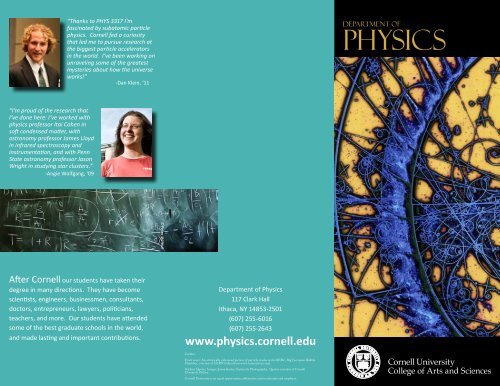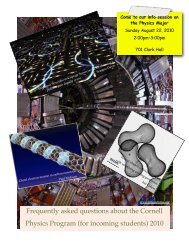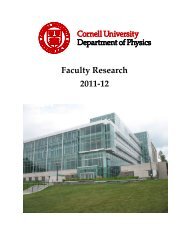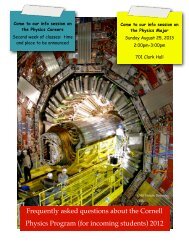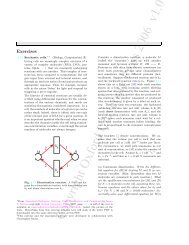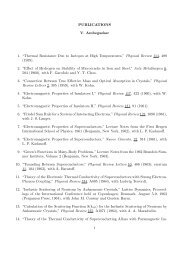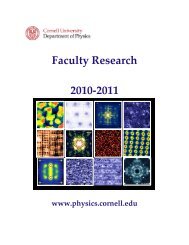Physics - Cornell University
Physics - Cornell University
Physics - Cornell University
- No tags were found...
Create successful ePaper yourself
Turn your PDF publications into a flip-book with our unique Google optimized e-Paper software.
“Thanks to PHYS 3317 I’mfascinated by subatomic particlephysics. <strong>Cornell</strong> fed a curiositythat led me to pursue research atthe biggest particle acceleratorsin the world. I’ve been working onunraveling some of the greatestmysteries about how the universeworks!”-Dan Klein, ‘11Department of<strong>Physics</strong>“I’m proud of the research thatI’ve done here: I’ve worked withphysics professor Itai Cohen insoft condensed matter, withastronomy professor James Lloydin infrared spectroscopy andinstrumentation, and with PennState astronomy professor JasonWright in studying star clusters.”-Angie Wolfgang, ‘09©Peter WittichAfter <strong>Cornell</strong> our students have taken theirdegree in many directions. They have becomescientists, engineers, businessmen, consultants,doctors, entrepreneurs, lawyers, politicians,teachers, and more. Our students have attendedsome of the best graduate schools in the world,and made lasting and important contributions.Department of <strong>Physics</strong>117 Clark HallIthaca, NY 14853-2501(607) 255-6016(607) 255-2643www.physics.cornell.eduCredits:Front cover: An artistically enhanced picture of particle tracks in the BEBC, Big European BubbleChamber, courtesy of CERN (taken from www.interactions.org).Student Quotes: Images, Jason Koski, <strong>University</strong> Photography. Quotes courtesy of <strong>Cornell</strong>Chronicle Online.<strong>Cornell</strong> <strong>University</strong> is an equal opportunity, affirmative action educator and employer.
A degree in physics provides a deep understanding of the most fundamental phenomena inthe universe while developing modes of thought and approaches to problem-solving that are valued inacademia, industry, and beyond. These skills empower <strong>Cornell</strong> physics graduates to succeed in a widerange of careers, such as medicine, law, public policy, financial services, education, engineering andsciences such as physics, astronomy, chemistry, and mathematics.CMS Detector, Switzerland.The physics major at <strong>Cornell</strong> is flexible,with the option to take courses of varyingmathematical sophistication. Students choose toconcentrate in an area of interest: either physics,or a complimentary field. The program of study iscustomized for each student.©Peter WittichOur faculty, including Nobel Laureates and aMacArthur Fellow, are internationally recognizedfor their teaching and research. Their ongoingefforts at running a dynamic and modern programmeans that they are frequent recipients of <strong>Cornell</strong>’sInnovations in Teaching Awards.Research is an important component ofour program, and most <strong>Cornell</strong> physics majorscollaborate with faculty and graduate studentson world-class research. <strong>Cornell</strong> is one of lessthan a dozen US universities to have a high energyaccelerator and synchrotron source on campus.Our nanofabrication facilities are unsurpassed, andour infrastructure for biophysics is among the mostsophisticated in the world.<strong>Cornell</strong> students at CERN, Switzerland.Opportunities abound for being involved inour community. Many of our undergraduates findtheir place in our physics societies: the Society for<strong>Physics</strong> Students (SPS) and the Society for Womenin <strong>Physics</strong> (SWIP). Our students give to the broadercommunity through outreach activities, and havethe opportunity to develop their teaching skillsthrough our Undergraduate Teaching Assistant (UTA)program. We host colloquia, technical seminars,and public lectures,bringing several world experts tocampus every week. Interactions with these visitors,and with <strong>Cornell</strong> researchers, provide our studentswith unrivaled opportunities for personal andprofessional development.©Peter WittichOur program boasts excellent student toteacher ratios, with a median class size of 16 inupper level courses. Introductory courses have40-150 students in lectures, but break into groupsof less than 20 for recitations and labs. All of ourcourses are taught by PhD physicists - mostlytenured faculty.w w w . p h y s i c s . c o r n e l l . e d uA <strong>Cornell</strong> student researching in a physics lab.©Robert Barker, <strong>University</strong> Photography


